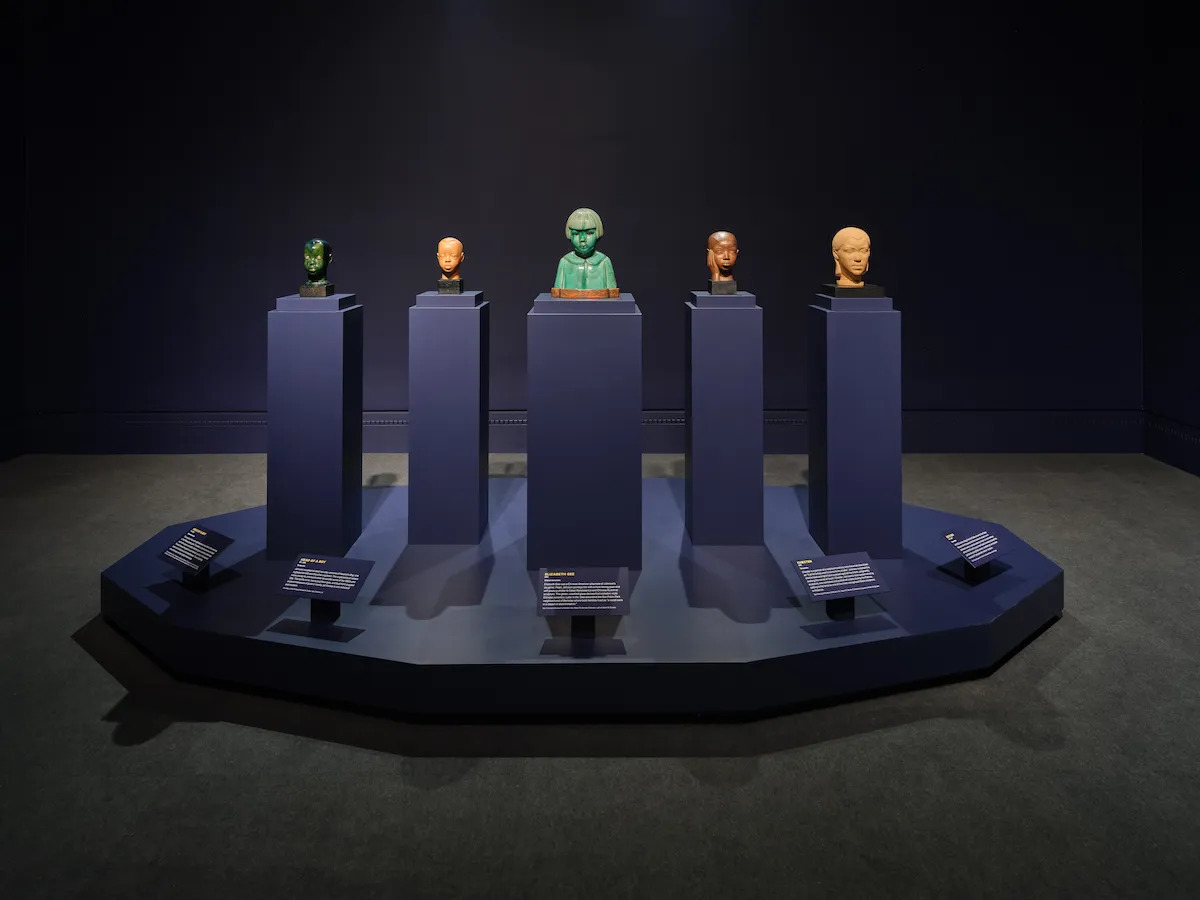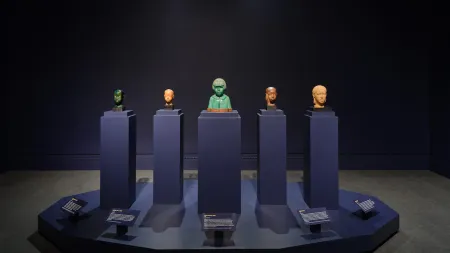
There was arguably no Black modernist who received more acclaim in the United States during his lifetime than Sargent Claude Johnson, a sculptor who spent his five-decade career during the early and mid-20th century in the Bay Area, all the way across the country from his contemporaries involved in the Harlem Renaissance movement.
Johnson received a prize from the Harmon Foundation, an organization that supported Black American artists before most institutions did so. He was picked to do grand commissions, including a 185-foot-long frieze for a San Francisco high school that displays an array of athletes leaping, diving, and running. And he was beloved among his cohort. Loïs Mailou Jones paid homage to Chester, Johnson’s 1931 bust of a Black boy with a palm to his cheek, in a painting of her own. Noted Black thinkers of the era sang his praises, including Alain Locke, who once wrote that Johnson had “come to reflect more than any other contemporary Negro sculptor the modernist mode and the African influence.”
And yet, today, beyond the Bay Area, Johnson is a lesser-known figure of 20th century art history. The Museum of Modern Art and the Whitney Museum, the two New York institutions commonly credited with writing a canon of American modern art, do not own a single work by Johnson. The artist himself has not had any major shows since 1998, the year that San Francisco Museum of Modern Art mounted a survey. Not, at least, until right now.

Johnson is getting more overdue recognition in the form of a modest but mighty survey held at the Huntington Library, Art Museum, and Botanical Gardens in the tony Los Angeles suburb of San Marino. The exhibition places a grouping of sculptures by Johnson alongside paintings, prints, and more, all in an effort to uphold him as a tireless innovator, an artist whose style was constantly in flux—even when the general public wasn’t always looking.
“Johnson was one of the key artists of the Harlem Renaissance period, but he’s not as well known today, partly because he was based the Bay Area in the 1920s and ’30s,” said Dennis Carr, the exhibition’s lead curator. “With this exhibition, we tried to place him within the Harlem Renaissance period, and to focus on his beautiful, dignified depictions of Black people and people of color in this time period. But then, we also wanted to look at his artistic experimentation throughout his career.”
Moreover, Johnson’s work acted as a retort to what was coming out of New York, which was predominantly painting. Jacqueline Francis, a scholar who organized the show with Carr and John P. Bowles, said “Johnson was the epitome of what the Harlem Renaissance artists could do in 3D.”
Johnson’s reappraisal has come as the Harlem Renaissance itself undergoes some reconsideration. This month, the Metropolitan Museum of Art opened a sprawling show about the movement, commonly associated with New York of the 1920s and ’30s, that seeks to situate it within modernism more broadly. That exhibition, curated by Denise Murrell, does put forward the Harlem Renaissance as a distinctly American movement intended to create new images of Black people that are freed from academicism and naturalism. But the Met show also asserts that the name is something of a misnomer, in that the movement wasn’t limited to just its namesake neighborhood—artists such as Richmond Barthé and Augusta Savage worked in styles that were indebted to what was taking place abroad, in the Caribbean and Europe.

On the other side of the US, on the Pacific, there was Johnson, who was synthesizing modes culled from Africa, Latin America, Asia, and, naturally, Harlem to devise his own style.
His most famous work remains Forever Free, a 1933 sculpture owned by SFMOMA that depicts a Black woman with her two children incised into her long, black skirt. The figures, with their almond-shaped eyes and their fleshy bodies, are done in an aesthetic that is distinctly Johnson’s. Their messaging is, too: this familial trio is literally inseparable, suggesting that they require each other’s love to continue on.
But in the decades that followed, Johnson veered in many other directions, producing enamelwork abstractions, public artworks for the Depression-era Works Progress Administration, and sculptures that look quite unlike Forever Free, such as a 1933–34 organ screen that Johnson made for an auditorium in the California School for the Blind in Berkeley. That work, which was thought to be lost for decades, was acquired by the Huntington about a decade ago.

“His story is one that really helps us understand the complexity of mid-century American artists,” said art historian Gwendolyn DuBois Shaw, who worked as a research assistant on SFMOMA’s 1998 Johnson show. “His work has often been tethered to the Harlem Renaissance, but in a way, it kind of has nothing to do with it.”
Shaw’s contribution to the Huntington show is a catalogue essay that doubles as a deep dive into Johnson’s upbringing, the details of which had previously been hazy. Johnson was born in 1888 in Boston, the city to which his parents had moved five years earlier. His parents were an interracial couple—not all US cities would have allowed them to wed at the time. Boston did so. But not all of Johnson’s family members fared so well: his uncle Lindsey narrowly escaped being lynched in Alexandria, Virginia, amid what Shaw describes as “a misunderstanding with a white woman.”
Yet Johnson, who was light-skinned, was afforded opportunities rarely experienced by Black Americans at the time, attending boarding school and receiving a formal education there. He ended up working for a railroad company as a dining car waiter, even as he took art classes in the Bay Area, where he moved permanently in 1915. (He would go on to study at the California School of Fine Arts, which ultimately became the famed, and now defunct, San Francisco Art Institute.) Working on trains, Shaw believes, may have enabled Johnson to traverse the country.

As Johnson’s career took off in the Bay Area, he bore witness to an influx of art from seemingly every corner of the world. He saw African artworks in the galleries of museums and in local private collections, and went on to make mask-like sculptures of his own. He is thought to have drawn inspiration from East Asian art for some of his sculptures; he even worked as an assistant to the artist Beniamino Bufano, who created a monument to Sun Yat-sen, China’s first President. He viewed paintings by Diego Rivera and other Mexican modernists when they traveled to San Francisco in the 1930s and ’40s, then made works in which he, too, arranged figures in rows. But Johnson cast off Rivera’s leftist themes in favor of something that was intentionally less political.
And, while Johnson is most closely associated with the Bay Area, not all of his time was spent there. He traveled widely, too, visiting Mexico himself on scholarship from the San Francisco Art Association in the mid-’40s.
Unlike many Harlem Renaissance artists, Johnson did not spend all day in his studio—he worked to earn a living. He produced frames for a shop and gallery, he worked in other artists’ studios, he colored pictures produced by a local photographer. He labored away.
Francis, the scholar who worked on the Huntington show, said she wanted “to disabuse people of the notion that everybody goes to art school, and then becomes represented by a blue-chip gallery. We know that for certain artists—women of color, as well as people of color in general—that has not been the route. In general, most artists work gigs.”
Johnson thought of himself first and foremost as an artist, and that ended up proving a stumbling block for his wife Pearl. Because Johnson took a path that did not lead to much financial success, Pearl “couldn’t realize her Black bourgeois desires,” Shaw said, “which may have contributed to her psychological struggles. She lived the final half of her life in a state mental hospital. It’s so sad.”

The later stages of Johnson’s own career were just as tragic in their own ways. During the ’50s, he became a barfly, only to end up the next decade living in a residential hotel in the Tenderloin, a hardscrabble San Francisco neighborhood, while his health declined. He died there in 1967.
Johnson’s legacy has suffered in the decades following his passing, likely due to his geographical location, which kept him out of view of the New York–centric American art world. But another important factor is that there hasn’t been a formal structure for how to further it. “He had no estate, as far as we know, to foster his legacy,” Carr, the Huntington curator, explained.
Even as historically white-led museums are only belatedly coming to recognize Johnson, Black artists have been looking to his sculptures for years. The painter Robert Colescott, a family friend of Johnson, was vocal in his support for the artist. And Faith Ringgold, in a 1994 work that is part of a series called “The French Collection,” even painted Johnson into an imagined gathering of modernists that also includes Henri de Toulouse-Lautrec, Paul Gauguin, Elizabeth Catlett, and Romare Bearden.
The Huntington show, in its own way, seems designed to weave Johnson into the fabric of art history, just as Ringgold did. And for Carr, that’s necessary work, since Johnson produced images of Black people that were unlike most others from the era.
“His early sculptures of people of color have such profound dignity,” Carr said. “In an era when so many images of people of color in popular culture were racist, that move of presenting his figures with such dignity, and nobility, even through their associations with ancient sculptural traditions, is a powerful one. That is the message he’s trying to deliver.”
Will Ferrell, Owen Wilson, and Many More Celebrities Spotted at Frieze Los Angeles
A Giant of Cape Town’s Art Scene Sets up Shop in Los Angeles, With Plans to Reach a New Community

This Semi-Autonomous Flying Car Could Soon Fly You to Work at 120 MPH

Blackpink’s Jennie Fronts Chanel’s Première Édition Originale Campaign

Today’s deals: $189 AirPods Pro 2, $150 off eero Pro 6E mesh, Instant Pot air fryers, Fire Sticks, more

Dartmouth Seeks Delay of Basketball Union Election


